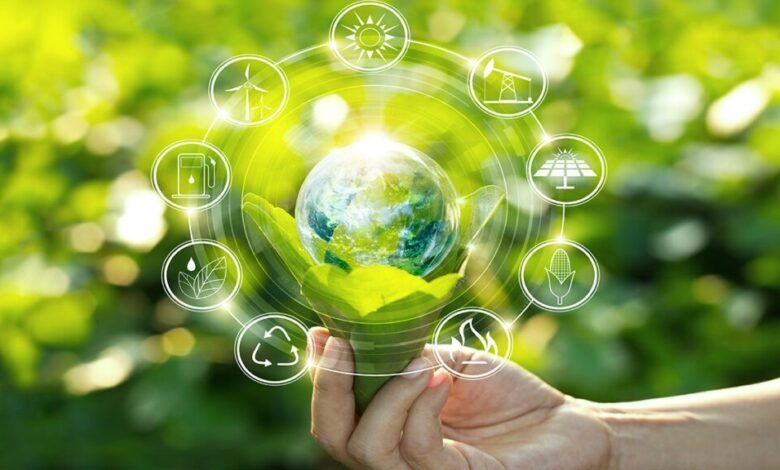Green Technology: Innovations for a Sustainable Future

Introduction
Green technology, also known as clean or sustainable technology, is at the heart of global efforts to combat climate change and reduce environmental degradation. By leveraging renewable resources and minimizing waste, green technologies aim to create a sustainable future for generations to come. This article explores the latest innovations in green technology, their real-world applications, and their transformative potential for achieving a more sustainable planet.
What is Green Technology?
Green technology refers to the use of science and innovation to create environmentally friendly solutions that reduce carbon footprints and promote sustainability. These technologies aim to optimize resource usage, reduce pollution, and enhance energy efficiency. From renewable energy systems to waste management innovations, green technology encompasses a wide range of applications designed to protect and preserve our planet.
See also: Augmented and Virtual Reality: Expanding the Digital Experience
Top Innovations in Green Technology
1. Renewable Energy Systems
Renewable energy technologies are at the forefront of green innovation, providing sustainable alternatives to fossil fuels. Solar, wind, hydroelectric, and geothermal energy systems are transforming the global energy landscape.
- Solar Power: Advancements in solar panel efficiency and the rise of solar farms are making this technology more accessible.
- Wind Energy: Offshore and onshore wind turbines are providing significant clean energy contributions worldwide.
- Hydroelectric Power: Modern hydro systems are now designed to minimize ecosystem disruption.
- Geothermal Energy: Harnessing heat from beneath the Earth’s surface offers a stable and sustainable energy source.
2. Energy Storage Solutions
Energy storage technologies, such as advanced batteries, are critical for maximizing the efficiency of renewable energy systems.
- Lithium-Ion Batteries: Widely used in electric vehicles and renewable energy grids.
- Solid-State Batteries: A promising innovation offering higher energy density and safety.
- Hydrogen Fuel Cells: A clean energy alternative for vehicles and industrial applications.
3. Smart Grids and Energy Management
Smart grids integrate renewable energy sources and optimize energy distribution for efficiency and reliability.
- IoT in Energy: Devices connected through the Internet of Things (IoT) enable real-time monitoring of energy consumption.
- Demand Response Systems: Balancing energy supply and demand to reduce wastage.
- Blockchain in Energy: Facilitates transparent and decentralized energy transactions.
4. Sustainable Agriculture
Green technology is revolutionizing agriculture by promoting sustainable practices and reducing environmental impact.
- Vertical Farming: Growing crops in stacked layers to maximize space and minimize resource use.
- Precision Agriculture: Using data-driven insights to optimize water, fertilizer, and pesticide usage.
- Organic Farming Technologies: Innovations in biofertilizers and pest control that prioritize ecosystem health.
5. Green Construction Materials
Sustainable construction practices and materials reduce the environmental footprint of buildings.
- Recycled Materials: Using recycled concrete, glass, and metals for construction.
- Low-Carbon Cement: An eco-friendly alternative to traditional cement.
- Green Roofs and Walls: Promote insulation and biodiversity in urban settings.
6. Electric Vehicles and Sustainable Transportation
Transportation is one of the largest contributors to greenhouse gas emissions. Green technology is addressing this through innovations in electric mobility.
- Electric Cars: Continued advancements in EV range and charging infrastructure.
- Public Transit Electrification: Cities adopting electric buses and trains for cleaner transportation.
- Micro-Mobility Solutions: Electric scooters and bikes for short-distance travel.
7. Water Purification and Management
Water scarcity is a pressing issue, and green technologies are essential in ensuring sustainable water use.
- Desalination Plants: Powered by renewable energy to turn seawater into potable water.
- Water Recycling Systems: Treating wastewater for reuse in agriculture and industry.
- Smart Irrigation: Automated systems that conserve water in agriculture.
8. Waste Management Innovations
Effective waste management is crucial for reducing pollution and conserving resources.
- Recycling Technologies: Advancements in separating and repurposing materials.
- Waste-to-Energy Systems: Converting organic waste into biogas or electricity.
- Composting Innovations: Turning food waste into valuable compost for agriculture.
9. Carbon Capture and Storage (CCS)
CCS technologies capture carbon dioxide emissions from industrial processes and store them underground to prevent their release into the atmosphere.
- Direct Air Capture: Systems that remove CO2 directly from the air.
- Enhanced Oil Recovery: Using captured carbon to extract oil more sustainably.
- Geological Sequestration: Storing carbon in stable geological formations.
10. Eco-Friendly Consumer Products
Consumers are increasingly opting for sustainable products, driving innovation in eco-friendly goods.
- Biodegradable Packaging: Alternatives to plastic, such as materials made from algae or cornstarch.
- Energy-Efficient Appliances: Products with high energy star ratings.
- Sustainable Fashion: Clothing made from recycled or organic materials.
Challenges in Adopting Green Technology
Despite its potential, the widespread adoption of green technology faces several challenges. These include high initial costs, limited awareness, and resistance to change from industries reliant on traditional methods. Additionally, scaling green technologies to meet global demands requires significant investment and policy support.
Global Efforts to Promote Green Technology
Governments, organizations, and communities are taking steps to promote green technologies.
- Incentives and Subsidies: Many governments offer tax breaks and subsidies for renewable energy installations and eco-friendly practices.
- International Agreements: Frameworks such as the Paris Agreement encourage countries to adopt sustainable solutions.
- Corporate Responsibility: Companies are embracing green initiatives to meet consumer expectations and reduce operational footprints.
The Role of Technology in Sustainable Development
Green technology is a critical enabler of the United Nations’ Sustainable Development Goals (SDGs). From clean water and sanitation to affordable clean energy and climate action, technological innovations are essential for achieving these global objectives.
The Future of Green Technology
The future of green technology is promising, with advancements in renewable energy, circular economy models, and climate-resilient infrastructure. Emerging trends include:
- Artificial Intelligence in Sustainability: AI-driven solutions for resource management and environmental protection.
- Bioengineering: Developing sustainable alternatives to traditional materials, such as lab-grown meat and bioplastics.
- Decentralized Energy Systems: Communities generating and sharing their own clean energy.
FAQs
1. What is green technology?
Green technology refers to innovations designed to minimize environmental impact, promote sustainability, and reduce carbon footprints.
2. How does green technology benefit the environment?
It reduces greenhouse gas emissions, conserves natural resources, and promotes cleaner energy solutions.
3. What are some examples of green technology?
Examples include solar panels, electric vehicles, smart grids, biodegradable packaging, and carbon capture systems.
4. Why is renewable energy important?
Renewable energy provides sustainable power without depleting natural resources or emitting harmful pollutants.
5. What are green building materials?
Green materials include recycled concrete, low-carbon cement, and eco-friendly insulation systems.
6. How can individuals contribute to green technology adoption?
By using energy-efficient appliances, supporting sustainable products, and adopting renewable energy solutions at home.
Conclusion
Green technology is an essential component of the global response to climate change and resource scarcity. By adopting innovative solutions, industries and individuals alike can contribute to a sustainable future. As technology continues to evolve, the possibilities for greener, more efficient systems are limitless. The path to sustainability lies in embracing these innovations and working collectively to protect our planet.




